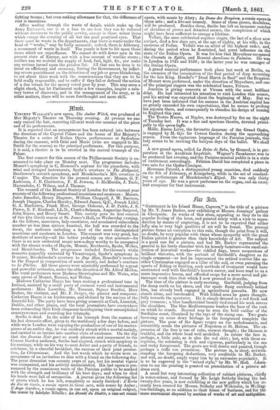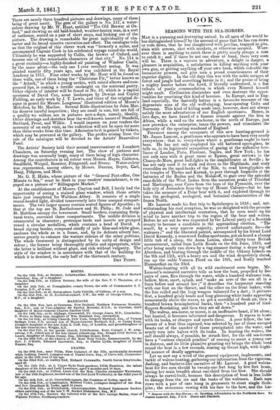" GARD3ALDI in his Island Home, Caprera," is the title
of a picture by Mr. T. Jones Barker, now exhibiting at Messrs. Jennings' gallery in Cheapside. In works of this class, appealing as they ° do to the popular feeling of the hour, and painted solely with a view to repro- duction by means of engraving, it is not to be expected that either lofty aim or very high qualities of art will be found. The present picture forms no exception to this rule, though the print from it will, no doubt, be very popular with those whose sympathy with the great Italian patriot is greater than their knowledge of Art. The subject is a good one for a picture, and had Mr. Barker represented the general in his lowly chamber with its homely furniture—its small col- lection of historical works—the riddled flags, brave mementoes of brilliant victories, with the portrait of Garibaldi's daughter as its single ornament—or had he represented the retired warrior like an- other Cincinnatus engaged as a tiller of the soil, or even pursuing the sports of fishing or hunting, such methods of treatment would have contrasted well with Garibaldi's known career, and have read to us a more impressive lesson, and afforded scope for a more novel and pic- turesque work than that which I now proceed to describe. The time of the picture is early morning. Garibaldi, judging from the damp earth on his shoes, and the' spade flung carelessly behind him, has already beef', engaged in agricultural pursuits. He now stauds alone, and bareheaded. With folded arms he gazes thought- fully towards the spectator. He is simply dressed in a red frock and grey trousers; a blue handkerchief loosely tied round his neck covers the shoulders. The blue Mediterranean washes the base of the rock on which he stands. Beyond may be seen the bold outline of the Sardinian coast, illumined by the rays of the rising sun. Two goats browsing on some dewy herbage in the fore„around complete the picture. The pose of the figure verges on the melodramatic and irresistibly. recaLs the pictures of Napoleon at St. Helena. The ex- pression of the face is one of calm, earnest thought; the likeness is truthful, and the whole head well modelled. In colour the face is, perhaps, a little pale, as is also the red shirt; but, with these ex- ceptions, the colouring is rich and vigorous, particularly in the sea and rocky foreground. The goats are well drawn and painted, though perhaps a trifle too prominent. The picture is, in short, notwith- standing the foregoing deductions, very creditable to Ir. Barker, and will, no doubt, amply repay him by an extensive popularity-. It is to be engraved in the "mixed style," by Mr. W. MAL Admis- sion to see the painting is granted on presentation of a private ad- dress card.
A small but very interesting collection of cabinet pictures, chiefly in water-colour, and formed by Mr. Leigh Sotheby during the last twenty-five years, is now exhibiting at the new gallery which has re- cently been erected for Messrs. Sotheby and Wilkinson, in Welling- ton-buildings, as an addition to their house of business, and for the more convenient disposal by auction of works of art and antiquities.
There are nearly three hundred pictures and drawings, many of them being of great merit. The gem of the gallery is No. 117, a water- colour drawing by Mr. W. Hunt, entitled "The Old Brewer at Ox- ford," and showing an old bald-headed, weather-beaten man, in a sort of outhouse, seated on a pair of short steps, and looking out of the picture. The drawing is remarkable for great individuality of cha- racter and its broad massive execution and effect. The catalogue tells us that the original of this clever work was "formerly a sailor, and accompanied Captain Cook in his celebrated voyage round the world. Ultimately he was supported by Collis, the brewer of Oxford, and became one of the remarkable characters of that city." No. 114 is a great curiosity—a highly-finished oil painting of Windsor Castle, by the same artist—the only one I ever recollect seeing. It was painted exactly fifty years ago, and was exhibited at the Royal Academy in 1811. Four other works by Mr. Hunt will be found on these walls, one of them being the "Christmas Pie," better known as the "Attack," in which a young urchin, with raised elbows and com- pressed lips, is making a terrific onslaught on the maternal pastry. Other objects of interest will be found in No. 58, which is a capital specimen of David Cox, some landscapes by Dewint and Copley Fielding, an early work by J. T. Lewis, and three of the original de- signs in pencil for Messrs. Longmans' illustrated edition of Moore's Melodies, by Mr. Maclise. Several Bible illustrations by John Mar- tin deserve careful inspection ; they are small in size, but are full of a quality we seldom see in pictures now-a-days, namely, ideality. Other drawings and sketches bear the well-known names of Stanfield, Stothard, Prout, and Wilkie. I would impress on your readers the necessity of an early visit, as the collection will not be open for more than three weeks from this time. Admission to it is gained by tickets, which may be procured at the gallery. The profits arising from the sale of the catalogue will be devoted to the Artists' Benevolent Fund.
The Artists' Society held their second conversazione at Langham Chambers, on Saturday evening last. The show of pictures and drawings was unusually large, many of them being of high character. Among the contributors in oil colour were Messrs. Hayes, Calderon, Smallfield, Weigall, Rossiter, Fitzgerald, and Storey. Water-colour was represented, among others, by Messrs. Duncan, Boyce, Carl, Haag, Pidgeon, and Mole.
Mr. G. E. Hicks, whose picture of the "General Post-office, One Minute to Six," must be fresh in your readers' remembrance, is en- gaged on a picture of "Billingsgate Market."
At the establishment of Messrs. Clayton and Bell, I lately had the opportunity of seeing a stained glass window, which those artists have just completed for Waltham Abbey. It consists of a single round-headed light, divided transversely into three unequal compart- ments. The two larger spaces contain seated figures of Apostles ; in that at the top are St. Bartholomew and St. Philip; St. Jude and St. Matthias occupy the lowermost. Small borders, containing Scrip- tural texts, surround these compartments. The middle division is ornamental in character; grotesque birds and insects are grouped round a circular medallion, which contains a head of David. A broad zig-zag border, composed chiefly of pale blue-and-white glass, encloses the whole as in a frame, and, by its delicate silvery hue, serves greatly to enhance the warmer colours of the other portions. The whole treatment is distinguished by its unity of design and colour ; the former being thoroughly artistic and appropriate, while the latter is brilliant without glare, and rich without vulgarity The style of the window is in accordance with that of the building for which it is destined, the early half of the thirteenth century.
DRY POINT.































 Previous page
Previous page